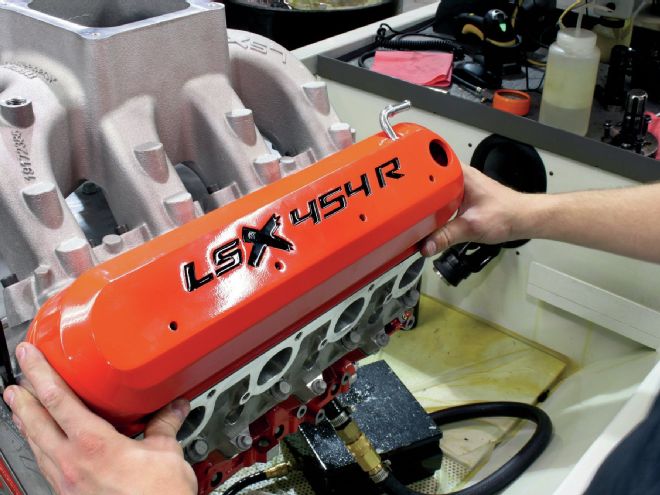
Chevrolet Performance engineers didn’t set out to create the most powerful crate engine in the company’s history. It was the fortunate consequence of their development process for the LSX454R drag racing crate engine. They were after durability first and foremost.
“We wanted big power, of course, but more than that, we wanted to give racers a reliable, low-maintenance engine that would go round after round and race after race throughout the season and require little more than oil changes and the occasional valve lash check,” says Rocko Parker, lead engineer. “In fact, this engine should go several seasons without the need for any major refreshing. That was more important to us than the final dyno number.”
For the record, this 13.1:1, naturally aspirated, and single Dominator-fed big-inch LS engine is officially rated at 770 horsepower at a 7,000 rpm and 612 lb-ft of torque at 5,600 rpm. And those figures might be a little conservative. Notably, that’s a 50hp increase over Chevrolet Performance’s own ZZ572/720R drag race crate engine—an old-school big-block that, while it cranks out 70 lb-ft more than the LSX454R, comes up short on horsepower despite being 26 percent larger in displacement. That’s huge.
Can an LS Engine Flow Some Air, or What?
“There’s almost no limit to what you can accomplish with an LS engine,” says Parker. “The LSX DR [drag racing] heads we used on the LSX454R flow incredibly well, but the entire intake side of the engine (manifold, carb, and camshaft) is designed with little restriction to move as much air as possible at high rpm.”
From the cylinder heads up, the LSX454R is unique, but its foundation is the sturdy bottom end that underpins the street-based LSX454, including an all-forged rotating assembly and the LSX Bowtie cylinder block. The latest version of the block, which includes provisions for six-bolts-per-cylinder head clamping over the production-spec four bolts per cylinder, is stronger than ever and supports even greater capability, should the owner decide to spray the engine. The 13.1:1 compression ratio is too high for supercharging or turbocharging, but that’s a topic for an entirely different story.
“Again, durability was the overriding goal for the engine and the LSX Bowtie block helps give us that,” says Parker. “We could have definitely squeezed a few more horses out of it, but we were concerned about longevity and how many quarter-mile passes it could take. The aim was to make sure it could withstand about two years of quarter-mile racing without the need for major maintenance.”
To that end, Parker says his engineers targeted camshaft lift below the 0.750-inch threshold and kept engine speed to 7,100 rpm. When it came to validating the engine’s dependability, the engineers used an electric dynamometer to simulate quarter-mile racing.
They dialed in the parameters of a race car that would run mid-9-second e.t.’s using a Powerglide-type two-speed transmission. The simulation was very close to a real event, starting with an idle and ramping up power to a 2-second WOT hold with a simulated transmission brake at 4,500 rpm. After that, they let the engine free to hit 7,000 rpm for the simulated First gear, before pulling it down to 4,500 rpm in less than 1 second to simulate the Second-gear shift and then back to 7,000 rpm as it “goes thru the traps.” The test even ramped down the engine speed after the “pass,” to simulate the braking portion and turn around, along with 30 seconds at idle to get back to the burnout box to do it all again.
“We did that for 600 trips down the simulated dragstrip, with only a shutdown every 50 events to verify valve lash and the health of the engine,” says Parker. “It was an aggressive validation case. The equivalent of about 8.5 hours of non-stop racing, not counting the health checks, but that’s what we wanted in the pursuit of a reliable bracket engine that someone will use in Super Comp, Super Gas, and classes like that.”
In the real world, 600 quarter-mile passes is a lot for most racers, something like six rounds every single week for two years. That’s a lot of racing. If the LSX454R proves as strong in the field as it did in the lab, those 770 horses are going to pull many a race car into the winner’s circle.
“We weren’t easy on the engine during development and it never failed,” says Parker. “It was making the same horsepower on the last quarter-mile simulation that it did on the first.”
The LSX454R is assembled at a specialized Chevrolet Performance facility in the Detroit area that blends the best of hand-assembly and production line techniques. Every component associated with the rotating assembly and the respective holes they fill in the block are mic’d with ultra-precise air gauge tools and their specifications recorded in a master file for each engine. Think of it as high-tech blueprinting.
Computer-controlled and calibrated torque wrenches ensure consistency with every engine, too, but they don’t replace the eyes and experience of specially trained builders who guide each engine from start to finish. There are only four stations involved with each engine’s assembly, with a single builder at each one responsible for specific tasks. In the first station, the rotating assembly and engine block are inspected, measured, and prepped for assembly. At the second station, the bottom end of the engine is installed. At the third stage, the heads and other top-end parts are added. The final station is an inspection stop, where each engine is subjected to a roster of checks, including leaks, compression, and oil pressure.
So, we bet you’re wondering what it takes to get into one of these bad boys. Although the LSX454R carries a list price of $24,037, the real-world price is less than $20,000 from high-volume retailers. That’s still a lot of engine for the money.
We asked Chevrolet Performance to let us document the assembly process and they obliged. It was a fascinating look at how a hard-core racing crate engine comes to life, which we are sharing in the accompanying photos.
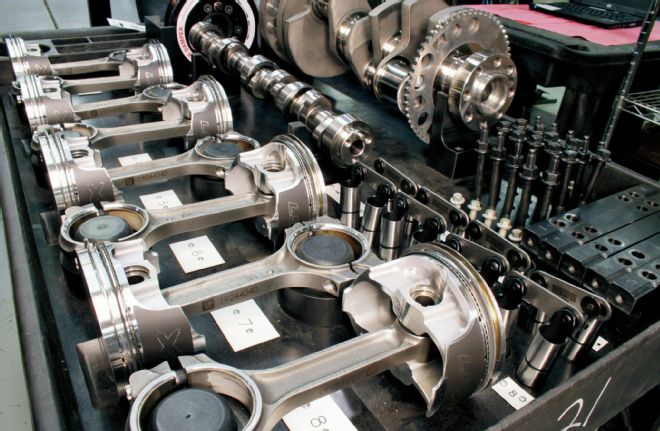
01. Components for the rotating assembly are collected prior to the start of the build. Chevrolet Performance uses nothing but forged components for the crankshaft, rods, and pistons, matching them with a mechanical roller camshaft.
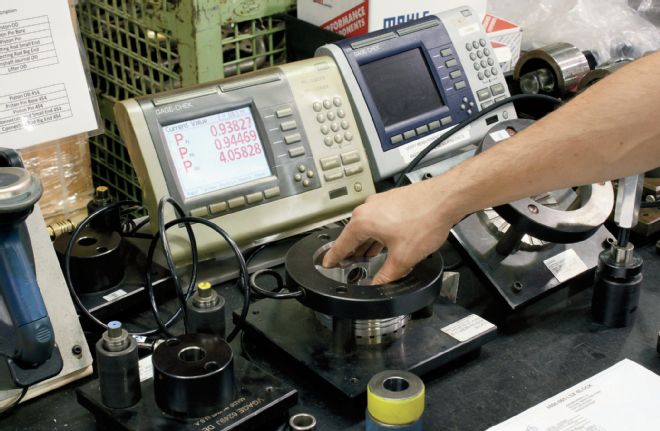
02. The rotating assembly parts undergo a series of inspections and measurements to ensure each conforms to the factory specifications. Here, a custom air gauge is used to measure the outer diameter of the pistons. Each is rotated within the fixture and air jets are used to determine the diameter, which is recorded on a master file for the engine.
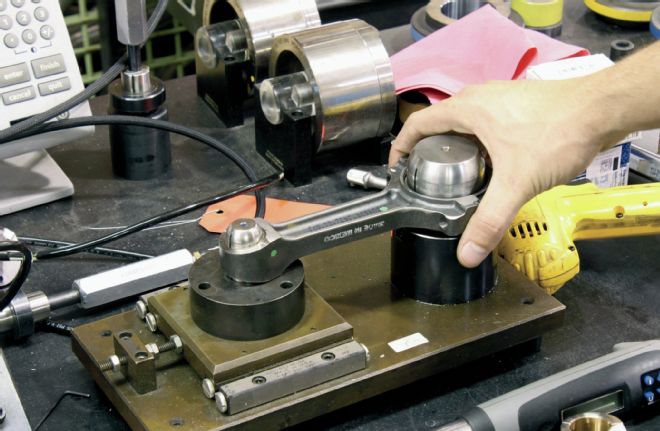
03. Like the pistons, each rod is measured with a custom air gauge tool, which measures the small and big ends simultaneously. The LSX454R uses 4340 forged steel I-beam rods that measure 6.000 inches in length. They also feature a larger small end to accommodate a larger wristpin.
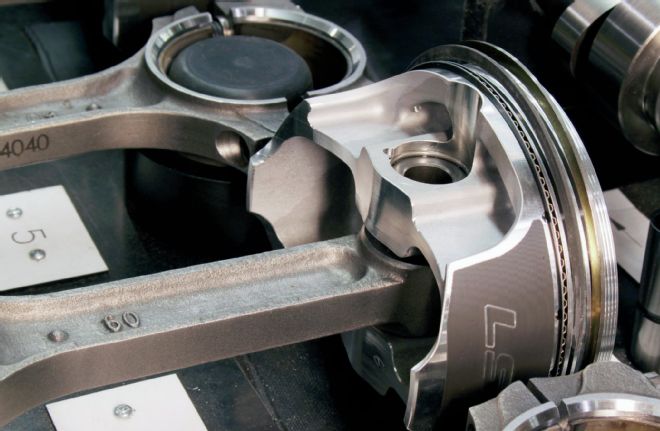
04. The 4.185-inch pistons are made of 4032 forged aluminum and use larger, 0.886-inch wristpins, necessitating the use of LSX rods that have complementing wristpin bores. They also feature forced pin oiling and a friction-reducing skirt coating.
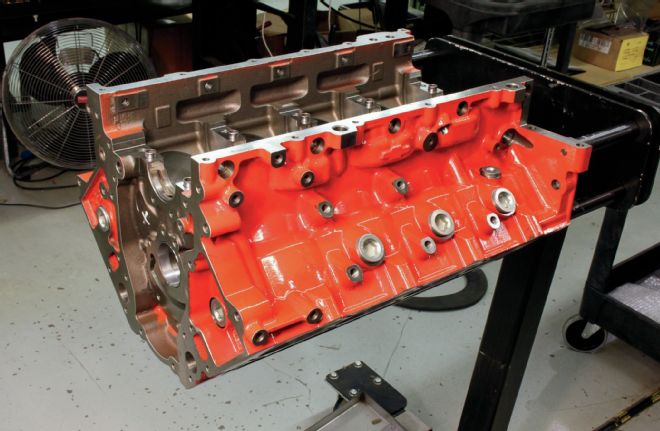
05. A cast-iron LSX Bowtie block with the standard 9.240-inch deck height is the engine’s foundation and is delivered to the assembly line already honed and cleaned. A deck plate is used to hone the cylinders, simulating the clamping pressure of the cylinder head on the deck to ensure optimal bore dimensions when the engine is assembled.
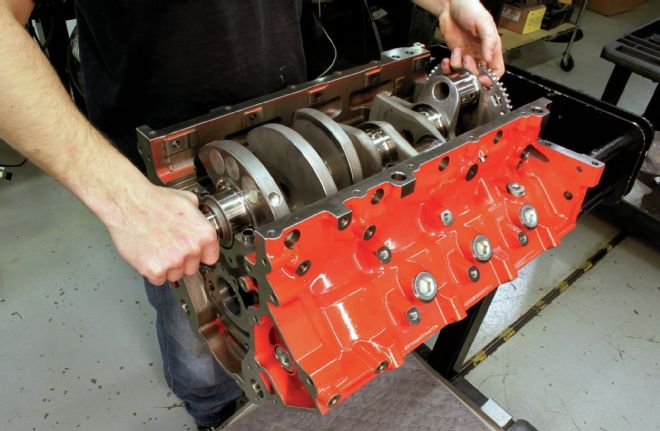
06. A 4340 forged steel crankshaft with a 58X reluctor wheel is carefully lowered into place, but prior to installation, the rod and main journals are measured in four places to calculate out-of-round and taper. Also, the crank’s snout and the damper’s internal diameter are measured to calculate the interference fit.
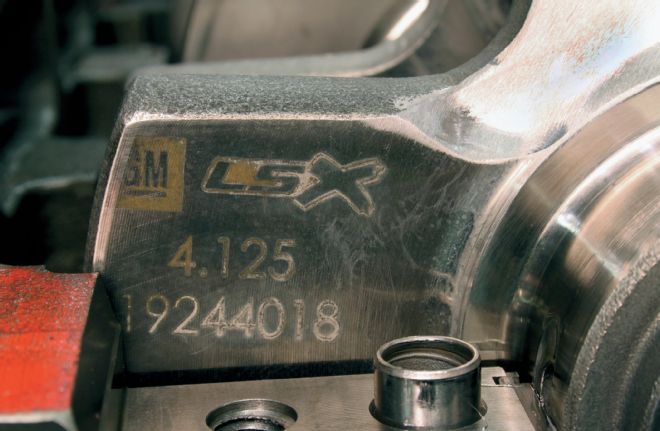
07. The crankshaft delivers a 4.125-inch stroke to achieve the engine’s 454 cubic-inch displacement with the 4.185-inch bores. A special windage tray is required to clear the long-stroke crank. The bottoms of the cylinder bores must be notched, too.
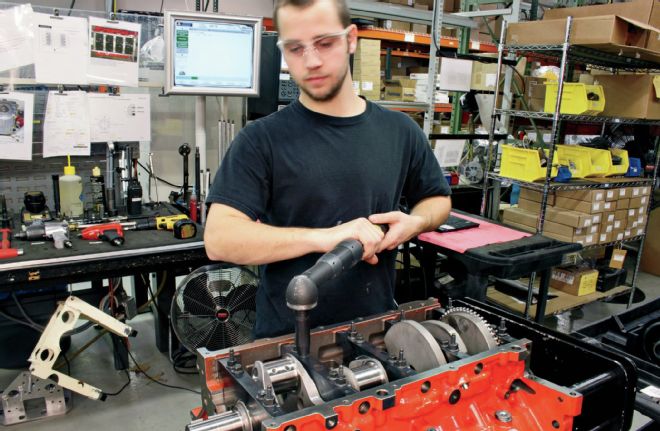
08. A keyway is built into the snout of the crankshaft to ensure the damper/crankshaft pulley stays put during high-rpm, full-load operation. The only production LS engine to incorporate a keyway was the Corvette ZR1’s supercharged LS9.

09. A computer-driven torque wrench is used to fasten the bolts on the main caps. The torque specs are programmed into the tool, which delivers perfect fastening force every time.
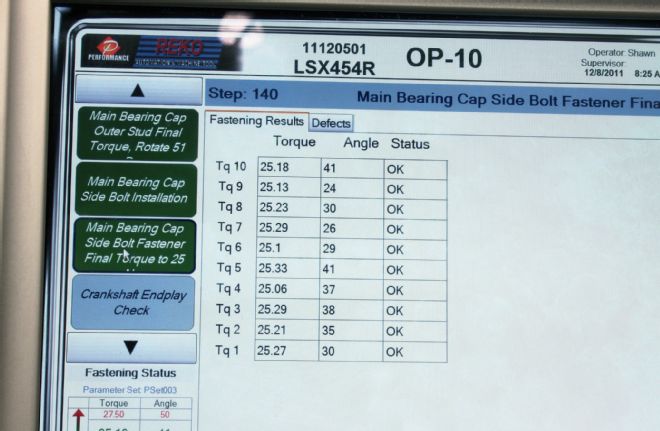
10. The fastener torque specs are verified by the computer and recorded on the engine’s permanent build record. In fact, the engine isn’t allowed to proceed to the next assembly stage if any of the fasteners for a particular assembly procedure don’t meet their respective torque specs.
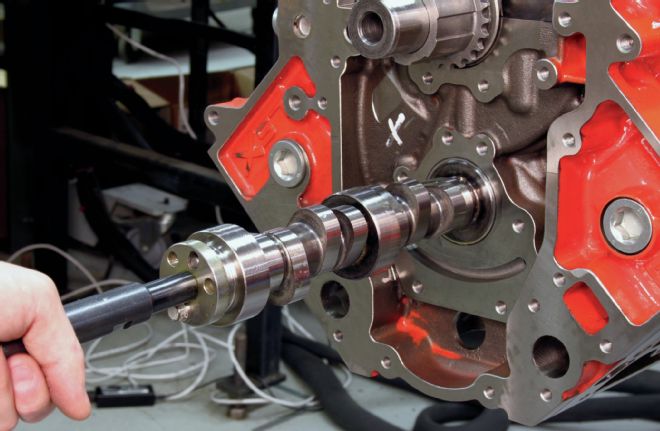
11. Next, the camshaft is inserted. For the LSX454R, it’s a special, mechanical roller design that delivers huge 0.738/0.738-inch lift and 250/270-degree duration at 0.050-inch lift. It’s designed for one thing: high-rpm airflow.
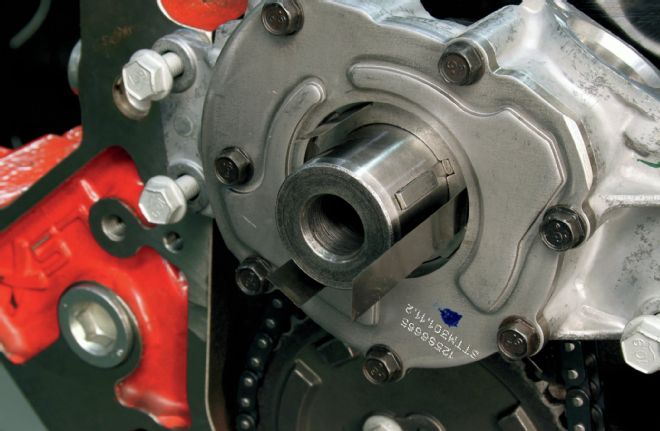
12. Shims—basically 0.002-inch feeler gauges—are used when installing the high-volume oil pump to ensure the proper alignment with the crankshaft centerline. It’s a critical installation step for all LS engine builds.
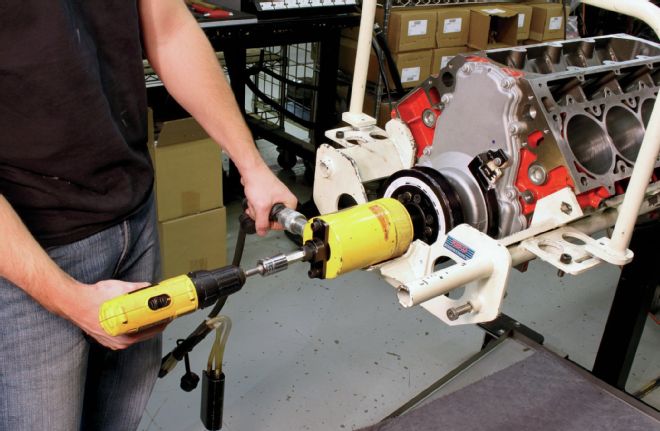
13. It takes a lot of pressure to drive the SFI-approved ATI damper onto the crank snout, and a hydraulic cylinder is used for the task. Then, the damper bolt is tightened with a 6:1 gear-reduction tool, because of the high-torque rating: 37 ft-lb plus 140 degrees.
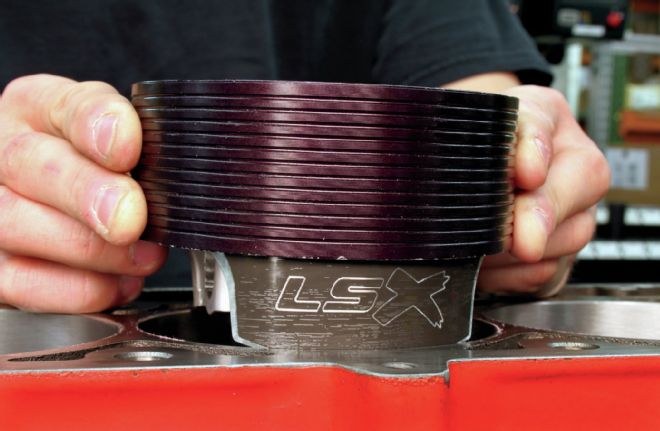
14. The piston/rod assemblies are slipped into place after the rod bearing received a coat of oil. Guide tools threaded onto the ends of the rods and a piston ring compressor ensure an easy, damage-free installation. The connecting rod caps are then torqued down to 64 ft-lb.
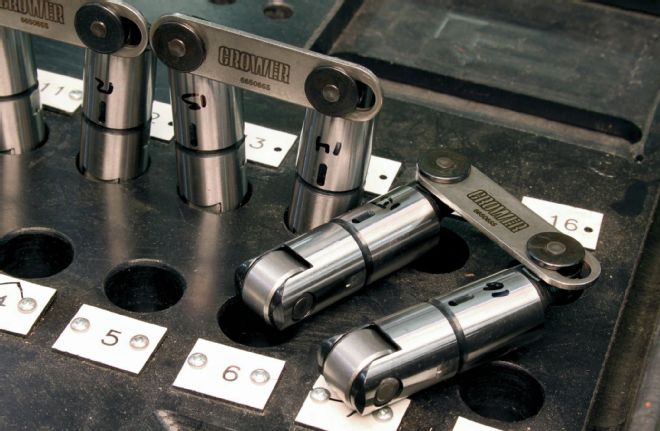
15. After that, a set of high-performance, mechanical tie-bar roller lifters are inserted in the block. The blade connecting each pair of lifters is thick steel for excellent support, while the lifter bodies themselves are CNC-machined and heat-treated steel.
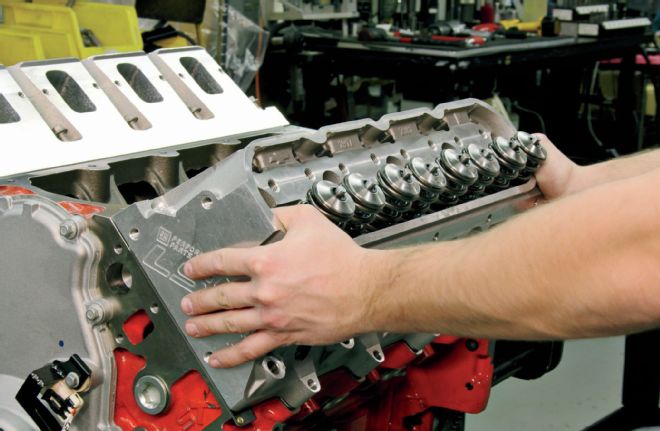
16. The cylinder heads are Chevrolet Performance’s LSX DR CNC-ported components that feature thick, 5/8-inch decks and are fitted with lightweight titanium intake valves. They also feature the LSX family’s signature six-bolts-per-cylinder clamping strength.
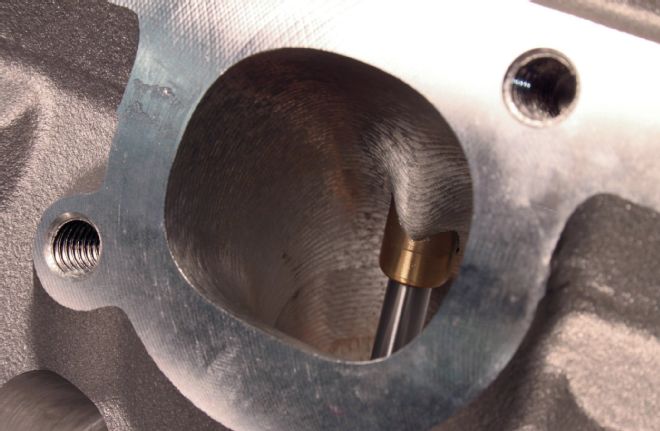
17. There’s plenty of room for airflow in the DR heads, with 313cc intake ports and 116cc exhaust ports. The combustion chambers displace 50cc and the valves measure 2.250 inches on the intake side and 1.625 inches on the exhaust side.
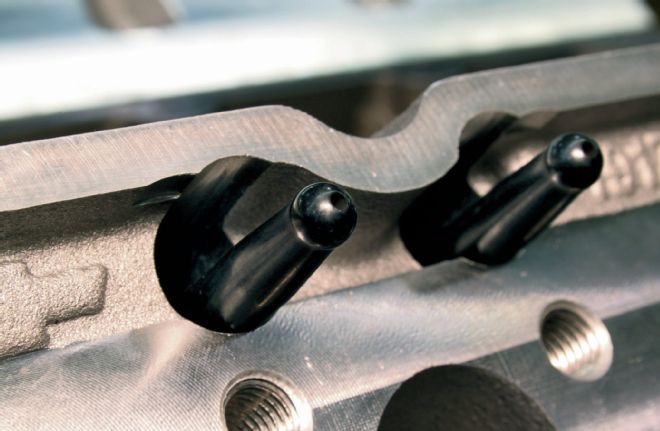
18. Large, heavy-duty pushrods with thick 7/16-inch walls support the engine’s strength and durability.
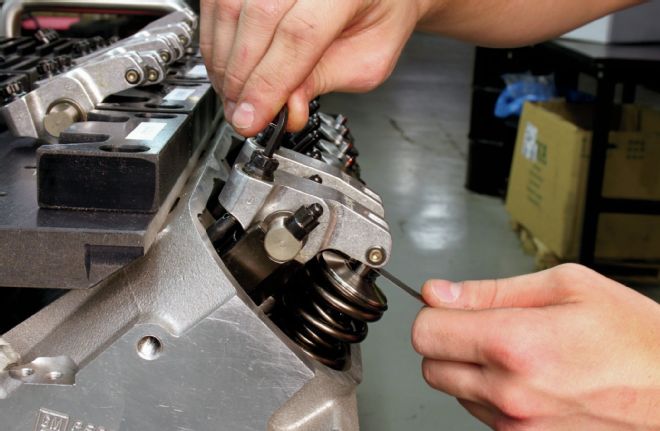
19. The valves are held at an 11-degree angle in the LSX DR heads, versus 15 degrees in most production LS engines. The dual-coil valvesprings are used with titanium retainers and shaft-mounted, aluminum roller rocker arms (1.9 ratio).
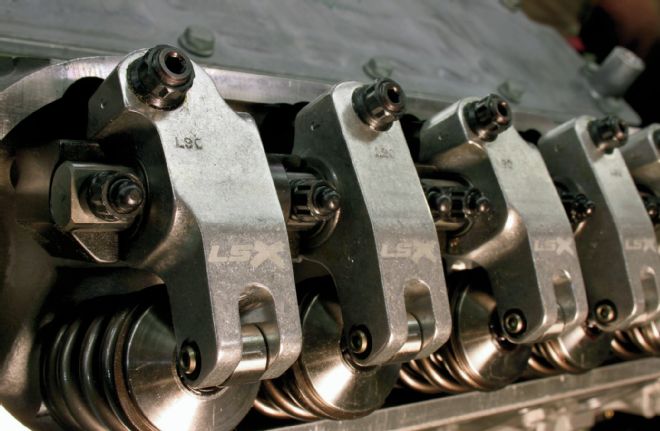
20. Shaft-mounted rockers enhance valvetrain stability at rpm and support greater horsepower. Engineers experimented with various valvetrain geometries before settling on a setup that would support the engine’s 7,000-rpm capability. Note the LSX insignias on the rockers’ bodies. Nice detail.
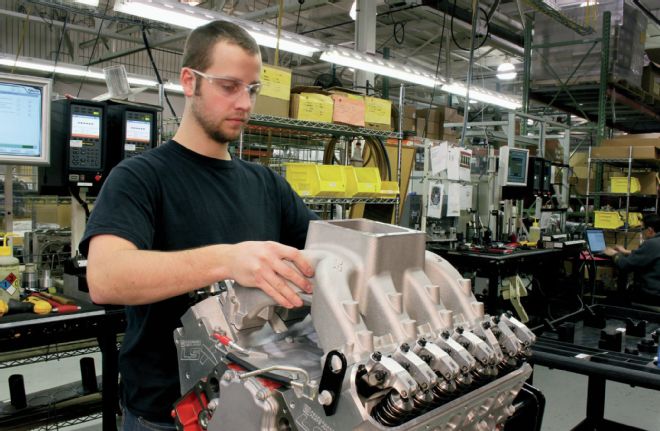
21. The engine assembly is topped off with a high-flow, aluminum single-plane intake manifold designed for the rectangular port design of the LSX DR heads. The crate engine package includes a Holley 1,150-cfm Dominator carburetor.
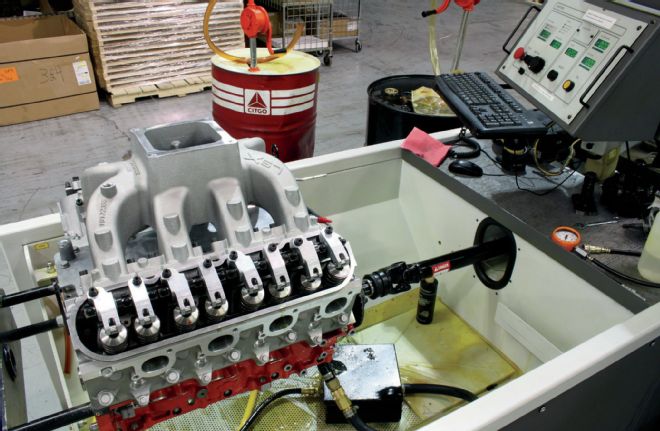
22. After the intake is installed, the engine is moved to the final inspection station, where it is leak-tested by pumping the water passages with about 20 psi of compressed air. The engine is also primed with warm oil to validate oil pressure, and the compression is checked.
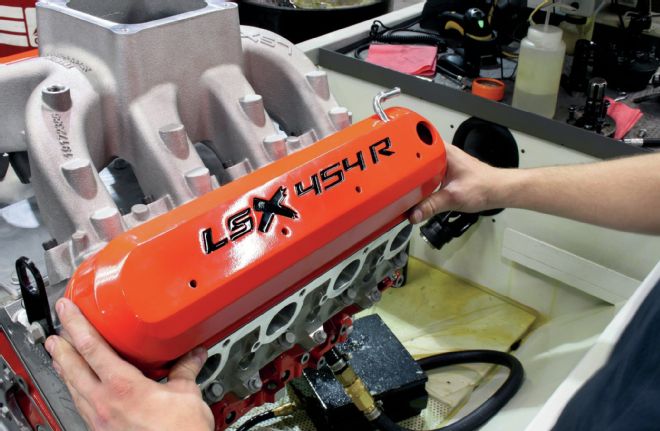
23. The final step before preparing the engine for shipping is installing the distinctive LSX454R valve covers. After that, stick a fork in it, because this engine is done!
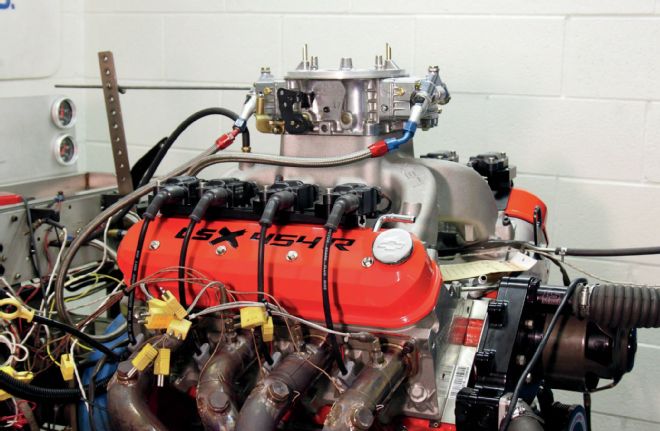
24. Although a full dyno test is not part of the assembly procedure, we were able to get a peek at a development engine as it was put through one of the tough validation tests, which simulated quarter-mile passes. Chevrolet Performance engineers subjected their test engine to the equivalent of 600 back-to-back blasts down the track.
Meet the DR525 – The Pioneer Drag Racing Spec Engine
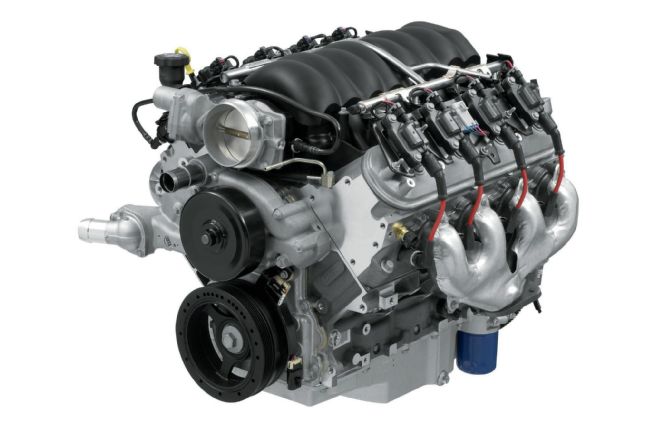
Chevrolet Performance’s new DR525 is more than just a crate engine intended for the strip. The 6.2L, naturally aspirated engine (rated at 525 horsepower) was developed expressly for the LS Stock class in the NMCA LSX Showdown Challenge. In fact, it features several tamper-proof bolts to ensure class compliance.
Think about that for a moment: It’s a sealed spec engine for drag racing. That’s a common practice in circle track racing, not drag racing, but Chevrolet Performance’s Jim Campbell says the idea behind the DR525 is similar: maintain costs for racers with a level powertrain playing field in the heads-up class. It’s a bold idea and we’ll know right away in the 2015 season if it was the correct one.
Importantly, the DR525 is also legal in other classes. It is offered in two part numbers: 19329009 (includes Chevrolet Performance’s muscle car oil pan) or 19329008 (includes fourth-generation F-body oil pan). Additional highlights include:
525 horsepower at 6,300 rpm and 489 lb-ft of torque at 4,400 rpm.
Production-based, aluminum cylinder block.
High-flow, LS3-type rectangular-port cylinder heads with 2.165/1.590 valves and beehive valvesprings.
10.7:1 compression ratio.
Hydraulic roller camshaft with 0.525/0.525-inch lift and 226/236-degree duration.
Production-style composite intake manifold with a 90mm throttle body.
Two tamper-proof bolts incorporated on the intake manifold, as well as a tamper-proof bolt on the front cover and the oil pan.
The assembly includes production-type cast-iron exhaust manifolds, fuel rails, injectors, coil packs, wires, spark plugs, LS3 water pump, and damper.
A tamper-proof E67-type engine control system from Chevy must be used with the engine in the LS Stock class.
And the price? Chevy says the DR525 carries a suggested retail price of $9,750 and the control system’s list price is $1,312.50. They also have a front accessory drive system that lists for $812.50. That’s roughly $11,000 for the whole shebang. Not bad for a 525hp racing engine.